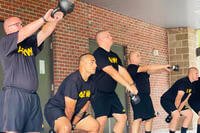If you are going to be carrying a boat on your head during waterborne special ops selection programs like Basic Underwater Demolition/SEAL (BUD/S) training one day, having a strong neck is vital to your success, but it goes much deeper than just training the neck.
First, the entire body should be strong enough to handle the load-bearing activities of boats, logs, rucks, equipment and fireman carries that you will see in the most difficult section of SEAL training: the first four weeks.
The first four weeks -- three weeks, plus the fourth week known as "Hell Week" -- is the time when each class loses 75%-80% of students due to failure to meet the standards, quitting or injury. Much of the attrition comes from being cold, uncomfortable and under a boat or log for many hours at a time.
If you spent your athletic life in the strength and power worlds of sports, you likely have created a strong enough foundation to handle the load-bearing seen in SEAL training. If you played sports that required strong necks, like football or wrestling, your neck will be strong enough to handle the loads, and preparing for that event will be minimal for you.
However, the strength athlete needs to worry more about endurance and muscle stamina, which will be tested with long days and nights of high repetition and many miles running, rucking, swimming and rowing.
The endurance athlete is just the opposite and needs to focus much more on strength and building a durable foundation to handle boats on heads and logs on shoulders.
Lifting weights for the cross country runner and the swimmer is an absolute necessity. Exercises like squats, deadlifts and cleans/overhead presses are helpful for the endurance athlete to build some mass and strength to handle the load-bearing challenges, but so is adding in neck strengthening exercises for any recruit who has not spent much time building a strong neck, back and legs.
The good news is that if you want to build your neck, you can start out with adding a few exercises to your normal calisthenics while in the prone position on the floor. For instance:
Safe Neck Movements (With or Without Weight)
Neck Up and Down/Side to Side: While on your back, lift your head up and down like you were saying yes, then change direction 90 degrees and move your head side to side. Then roll over on your side and lift your head up and down.
You can also lie on your stomach, do the same movements and work your neck in all four directions and planes of movement. The head typically weighs 10 pounds, and that is plenty of weight to build your neck to be strong enough to handle certain loads.
As sets of 25-50 reps in each direction get easier, you can add weight like a football helmet or a five- to 10-pound plate. No need to go heavy with this exercise. Then you can flip over onto your stomach and repeat the same movements to work the back side of your neck more.
Birds and Arm Haulers: This is a classic out of the PT Reset workout that stretches the chest but flexes the upper back and rear deltoid/trapezius muscles. However, you can add in some head movements up and down to work the neck a little more.
Flutter Kicks: You will have to do flutter kicks on the beach, in the surf zone and on the grinder so get used to the hip challenge that comes with flutter kicks in wet pants. The instructors will also require you to lift your head off the floor and work your neck at the same time as well.
Move your head up/down and left/right during the exercise to add in some neck work. Any abdominal or hip flexor exercise on the floor can add a neck component to it as well.
Avoid Compressing the Neck
Avoid neck bridges and even carrying heavy things on your head. The amount of compression from bridges and heavy head carries can take its toll on the bones and nerves of the neck and cause lifelong damage if not careful.
Building the neck to handle loads like this can be done without loading your spine vertically. Think of the amount of neck compression you do in training as something you want to limit in your life. Save it for the first four weeks of BUD/S.
When you carry objects on your head, brace your neck by pushing your chin in. You will feel the flex of the neck muscles, and it will be more stable for the load. This is like bracing your spine when you deadlift or do heavy squats by flexing the muscle around the spine to create a solid foundation.
Stew Smith is a former Navy SEAL and fitness author certified as a Strength and Conditioning Specialist (CSCS) with the National Strength and Conditioning Association. Visit his Fitness eBook store if you're looking to start a workout program to create a healthy lifestyle. Send your fitness questions to stew@stewsmith.com.
Want to Learn More About Military Life?
Whether you're thinking of joining the military, looking for fitness and basic training tips, or keeping up with military life and benefits, Military.com has you covered. Subscribe to Military.com to have military news, updates and resources delivered directly to your inbox.





















